Flax Milk Review and Updated Milk Chart
 People have been drinking milk since about 9,000 BC, which is around the time that we decided to settle down and start farming. If you take a walk through your grocery store today, you will see that this consumption has "evolved" tremendously since then. Though some dairies continue to drop off bottles of milk at your front door, most people grab their milks at the supermarket -- and it's not all traditional whole milk anymore. According to soyfoods.org, soymilk sales in the US are over $990 million. 89% of that is refrigerated soy milk (source: Soyfoods: The U.S. Market 2012, published by Soyatech, Inc. and powered by SPINS, Inc. data). The USDA asserts that milk sales in the U.S. during 2012 totaled 4,694,000 pounds of milk. That's about a 2% decline from the previous year.So what choices does the average consumer face? Well, first you can choose from 4 different types of cow's milk, based on fat content alone. That's skim (no fat), low-fat (1%), reduced-fat (2%), and whole (regular milk -- no fat removed). Plus, there are cow's milks that have been altered to be lactose-free or heart-healthy. If you don't want to consume animal products, you still have tons of milk choices. There's soymilk, rice milk, flax milk, almond milk, and coconut milk, and that's just a start! The best part? All of these milks can usually be found in your typical grocery store. With all of these myriad options, how can an informed consumer make a healthful choice? Why, that's where we come in! Take a look at this chart, which lays out a comparison of major types of the unsweetened milks that you can buy in grocery stores today.
People have been drinking milk since about 9,000 BC, which is around the time that we decided to settle down and start farming. If you take a walk through your grocery store today, you will see that this consumption has "evolved" tremendously since then. Though some dairies continue to drop off bottles of milk at your front door, most people grab their milks at the supermarket -- and it's not all traditional whole milk anymore. According to soyfoods.org, soymilk sales in the US are over $990 million. 89% of that is refrigerated soy milk (source: Soyfoods: The U.S. Market 2012, published by Soyatech, Inc. and powered by SPINS, Inc. data). The USDA asserts that milk sales in the U.S. during 2012 totaled 4,694,000 pounds of milk. That's about a 2% decline from the previous year.So what choices does the average consumer face? Well, first you can choose from 4 different types of cow's milk, based on fat content alone. That's skim (no fat), low-fat (1%), reduced-fat (2%), and whole (regular milk -- no fat removed). Plus, there are cow's milks that have been altered to be lactose-free or heart-healthy. If you don't want to consume animal products, you still have tons of milk choices. There's soymilk, rice milk, flax milk, almond milk, and coconut milk, and that's just a start! The best part? All of these milks can usually be found in your typical grocery store. With all of these myriad options, how can an informed consumer make a healthful choice? Why, that's where we come in! Take a look at this chart, which lays out a comparison of major types of the unsweetened milks that you can buy in grocery stores today.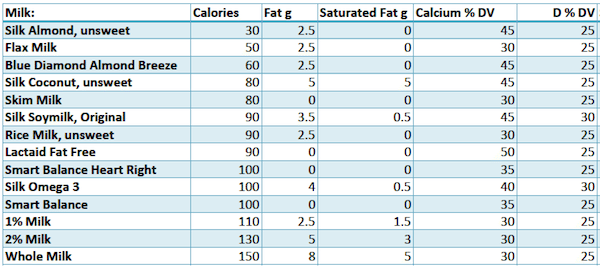 (We also have a PDF of this chart that contains all of the information above, as well as omega-3 counts and sterol content. Download it for free by scrolling to the bottom of this page and clicking the link). Here are the highlights of our chart...Lowest Calorie Content: The award here goes to Silk almond milk, which has just 30 calories in a single cup. Silk recently increased the calcium content in their milk from 30% of the daily value to 45% of the daily value, which means that they can now claim that their brands of milk contain 50% more calcium than regular cow's milk.King of Sterols: It was interesting to learn that Smart Balance Heart Right contains plant sterols in addition to 20% of the daily value for Omega-3s. Plant sterols help prevent the absorption of cholesterol in the bloodstream, so they may help lower cholesterol as part of a healthful diet. The official claim reads, "Foods containing at least 400mg per serving of plant sterols eaten twice a day with meals for a daily total intake of at least 800mg, as part of a diet low in saturated fat and cholesterol, may reduce the risk of heart disease."Coconut Milk CAN be Lower in Fat: While Silk's coconut milk is higher in fat and saturated fat than most other milks listed in this chart, it is still much lower in fat and saturated fat than canned coconut milk. Don't be fooled by the canned versions' 1/3 cup serving size. For the sake of comparison, we calculated what each version would contain when the serving size is upped to a cup...
(We also have a PDF of this chart that contains all of the information above, as well as omega-3 counts and sterol content. Download it for free by scrolling to the bottom of this page and clicking the link). Here are the highlights of our chart...Lowest Calorie Content: The award here goes to Silk almond milk, which has just 30 calories in a single cup. Silk recently increased the calcium content in their milk from 30% of the daily value to 45% of the daily value, which means that they can now claim that their brands of milk contain 50% more calcium than regular cow's milk.King of Sterols: It was interesting to learn that Smart Balance Heart Right contains plant sterols in addition to 20% of the daily value for Omega-3s. Plant sterols help prevent the absorption of cholesterol in the bloodstream, so they may help lower cholesterol as part of a healthful diet. The official claim reads, "Foods containing at least 400mg per serving of plant sterols eaten twice a day with meals for a daily total intake of at least 800mg, as part of a diet low in saturated fat and cholesterol, may reduce the risk of heart disease."Coconut Milk CAN be Lower in Fat: While Silk's coconut milk is higher in fat and saturated fat than most other milks listed in this chart, it is still much lower in fat and saturated fat than canned coconut milk. Don't be fooled by the canned versions' 1/3 cup serving size. For the sake of comparison, we calculated what each version would contain when the serving size is upped to a cup...
- Thai Kitchen Canned Regular Coconut Milk: 1 cup has 420 calories, 42 g of fat, and 36 g of saturated fat.
- Thai Kitchen Canned Light Coconut Milk: 1 cup has 150 calories, 13.5 g of fat, and 12 g of saturated fat.
- Silk Brand Coconut Milk: 1 cup has 80 calories, 5 g of fat, and 5 g of saturated fat.
Vitamin D and Calcium. The vitamin D content is about the same across the board, but many companies offer competitive claims for calcium.Choose Skim: If you're trying to pick a cow's milk, skim milk is a good choice, with about half the calories of whole milk, none of whole milk's fat, and the same amount of calcium as whole milk. For more information, check out this article about using fat-free half and half to ease a transition to skim milk.Let's Zoom in on Flax Milk!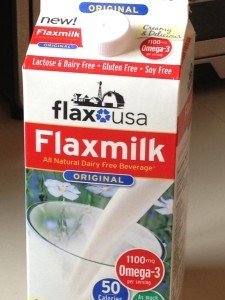 Flax milk is a relatively new player in the milk scene, so I thought I would see what all the fuss is about. The first thing that caught my eye was the calorie content - flax milk has just 50 calories per cup. Plus, it contains a hefty level of omega-3 fatty acids. In fact, its omega-3 content was the highest out of all the milks we researched, which makes it an excellent choice for people who need to increase their omega-3 consumption.The flavor is outstanding, and has been successfully teenager tested. I heard that the milk "tastes like cake batter." While I cannot remember the last time I served cake batter, I think this remark bodes well for the milk's palatability. Flax milk is an excellent milk alternative for people with lactose intolerances, soy or wheat allergies, or who wish to avoid consuming animal products.The only drawback I could find for this milk was the cost. That said, $5.99 per half gallon is certainly not a dealbreaker.
Flax milk is a relatively new player in the milk scene, so I thought I would see what all the fuss is about. The first thing that caught my eye was the calorie content - flax milk has just 50 calories per cup. Plus, it contains a hefty level of omega-3 fatty acids. In fact, its omega-3 content was the highest out of all the milks we researched, which makes it an excellent choice for people who need to increase their omega-3 consumption.The flavor is outstanding, and has been successfully teenager tested. I heard that the milk "tastes like cake batter." While I cannot remember the last time I served cake batter, I think this remark bodes well for the milk's palatability. Flax milk is an excellent milk alternative for people with lactose intolerances, soy or wheat allergies, or who wish to avoid consuming animal products.The only drawback I could find for this milk was the cost. That said, $5.99 per half gallon is certainly not a dealbreaker.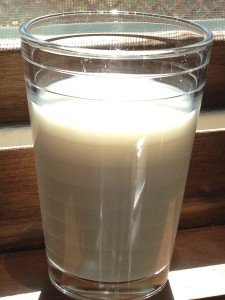
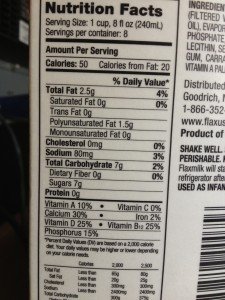
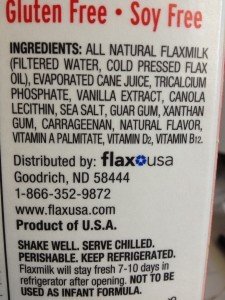
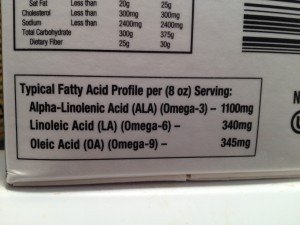 This blog post will soon be available as printer-friendly handouts for all our Food and Health Communications members. Don't miss out on all the fun (and free resources). Learn more about membership or sign up today!By Judy Doherty, PC IIData Sources: almondbreeze.com, FlaxUSA.com, Lactaid.com, Silk.com, smartbalance.com, tastethedream.com, USDA database.Speaking of shopping, we just finished one of our newest and most interactive PowerPoint show and program. It's about grocery shopping. You can watch it for free by clicking on the photo below...
This blog post will soon be available as printer-friendly handouts for all our Food and Health Communications members. Don't miss out on all the fun (and free resources). Learn more about membership or sign up today!By Judy Doherty, PC IIData Sources: almondbreeze.com, FlaxUSA.com, Lactaid.com, Silk.com, smartbalance.com, tastethedream.com, USDA database.Speaking of shopping, we just finished one of our newest and most interactive PowerPoint show and program. It's about grocery shopping. You can watch it for free by clicking on the photo below...
This show offers participants everything they need to know in order to shop well. It reviews how to use MyPlate to choose groceries by food group, includes experiments with smart phone grocery apps like Fooducate, and shares strategies for evaluating Nutrition Facts panels. The show combines lecture and group activities for prime participant engagement.Looking for more resources? Check out our Nutrition Education Store or browse products below...

 Download the extended milk information chart here for free!
Download the extended milk information chart here for free!


